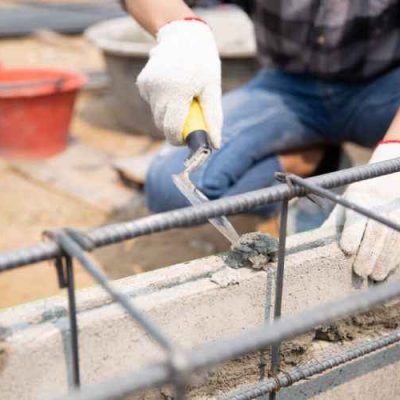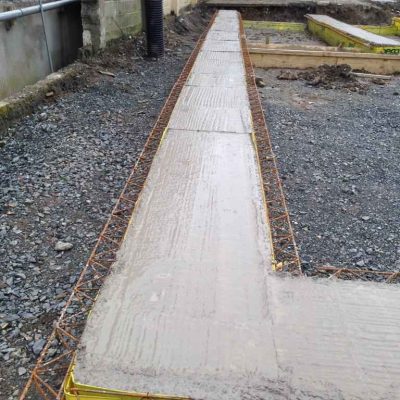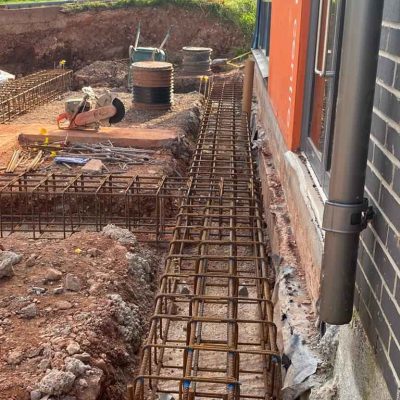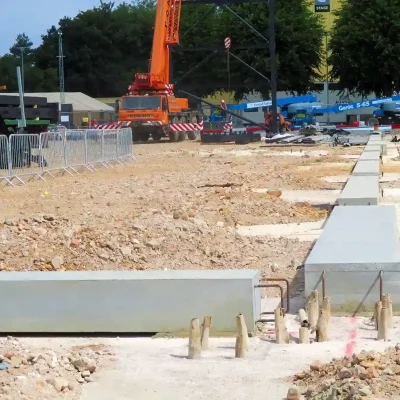Underpinning refers to the process of strengthening and stabilising the foundation of a building or structure that has settled, shifted or otherwise become unstable. It involves excavating the soil underneath the foundation and replacing it with a stronger material or adding additional support to prevent further movement or collapse.
When Is Underpinning Needed?
Most often, underpinning is necessary when the original foundation of a house cannot support the weight of the structure. Well, the following are the reasons why a building typically requires underpinning.
- Change in Building Usage or Nearby Construction- In cases where the building is being used differently following a major renovation or nearby construction causes excavation of the soil supporting existing foundations.
- Inadequate Foundation Support – The original foundation of a house cannot support the weight of the structure due to changes in the soil supporting the foundation, such as subsidence, moisture-induced expansion/contraction, damage caused by large trees or unrepaired plumbing.
- Poorly Designed Foundation – The soil conditions were not properly understood during the initial foundation design, rendering the foundation inadequate for the conditions.
- Additional Storey or Increased Load – When there is a need to enhance the competence of current foundations to bear the weight of an additional storey to accommodate your bigger family.
- Natural Disasters – Natural disasters like earthquakes, floods, or droughts may also necessitate underpinning if they cause the structure to shift or become unstable.
It is important to carefully consider the critical factors that impact the foundation of a building to determine if and when underpinning is necessary.
What are the Types of Underpinning? Their Pros & Cons
Now, you know what exactly is underpinning, and when it is required, it’s time to look at its three types.
Concrete Slab
The process of concrete slab underpinning has been in existence for several years. It involves enlarging and reinforcing foundations using concrete. Although it is effective, it can be quite costly and result in a messy construction site.
Pros
- Concrete underpinning is a proven engineering technique that has been used for over 100 years.
- It is typically employed for small underpinning jobs.
- It provides a new foundation beneath the existing one, increasing the foundation depth and extending it to stronger soil.
Cons
- Concrete underpinning can be a slow process, requiring time for the concrete to set.
- Excavation is necessary, which can be messy, and parts of your home may become unusable during the process.
- It is labour-intensive, which can inflate costs for bigger projects.
Screw Pile
Screw pile underpinning that involves the use of steel piers and concrete footings can be highly effective in securing a building and restoring it to its original position, thereby closing all gaps and cracks. However, this method can be costly and often involves significant excavation.
Pros
- Screw pile offers high installation speed, saving valuable construction time.
- Produces low noise during installation due to the absence of driving and vibration, reducing the potential harm to nearby structures.
- It is designed with blades that enable them to withstand various pulling loads.
Cons
- It can not be used in areas with high or moderate seismic activity.
- It is not suitable for penetration into rocky soil or areas with solid inclusions, such as slag dumps or landfills for construction waste.
Resin Injection
The most recent and demonstrated technique for underpinning is resin injection, which is a fast, clean, and cost-effective process.
It involves injecting an eco-friendly liquid resin into the foundation through a small aperture. The resin then permeates the soil and transforms into a solid gel, exerting pressure and pushing against the ground and the surrounding soil. The building is lifted as more resin is added.
However, it is crucial to have a professional consultation before using this technique as it may not be suitable for all ground conditions.
Pros
- Resin injection underpinning is a contemporary yet well-established technique used to reinforce and strengthen building foundations.
- It is a clean process that does not require excavation, eliminating dust and water.
- It is a relatively quick method, with most projects finished within a day or two.
- Residents can usually stay in their homes, and minimal furniture movement is involved.
- It has been a globally recognised and proven method for over 30 years, effectively reinforcing foundations and safeguarding the long-term integrity of your property.
Cons
- Resin injection underpinning requires practised technicians to monitor the injection process using precision instruments.
- The resin formula needs to be carefully mixed to suit specific weather and soil conditions.
- Professional consultation is necessary to determine if resin injection is suitable for all ground conditions.




What are The Causes of Foundation Heave?
Foundation heaves start beneath your house in the soil of your home. It is important to note that properties with denser foundations may experience settlement issues, while those with thinner foundations may experience foundation heaves.
Foundation heave occurs when the soil swells due to many factors that may include the following:
Stress Relief
Stress relief is when the soil is removed from an excavation, also known as overburden recovery. The pressure of layers below is relieved with stress relief, causing the soil to swell and heave upward.
Lack of Drainage
The lack of a proper drainage system in the house is a major cause of foundation heave. This can destabilise the soil under the foundation.
Though with heavier homes, lack of proper drainage leads to sinking but with lighter homes the soil will move upwards, causing damage and wall/tile deterioration.
Soil Saturation
One cause of soil saturation is a lack of proper drainage. However, there could be other issues, such as:
- Underground water sources
- Changes in the water table
- Flash floods
Snap Freezes
- Sudden and abrupt changes in the weather leads to foundation heave.
- One example of this is snap freeze which causes the water in the soil to expand; hence, putting pressure on the foundation.
Is Underpinning a Permanent Fix?
Well, the answer to whether underpinning is a permanent fix for foundation problems is a complex one, as it depends on various factors.
The effectiveness of underpinning in enhancing the overall stability of your property may vary in the long run, and this would depend on several factors, such as the kind of soil your property is erected on and the specific underpinning method employed.
It is important to note that not all foundation problems can be solved with underpinning, and a thorough assessment by professionals is necessary before determining if it is a suitable solution.
Why Do Building Foundations Fail?
Site Erosion
Soil erosion can cause significant issues, especially if it wears away the soil supporting a building’s foundations, leading to severe structural damage. A variety of factors, such as inadequate drainage systems, unregulated water flow, burst water pipes, and more, can cause it.
Reactive Soils
Foundation problems are often caused by the movement of reactive soils, which can experience shrinkage, settlement, and expansion leading to heaving. When the soil is consistently dry, it gradually drops moisture, making it shrink.
Conversely, when the soil is exposed to higher levels of moisture, such as during wet weather, it expands. Both shrinkage and expansion can lead to foundation compromise and result in cracks that can cause severe issues in the future.
Inadequately Compacted Fill
In cases where a site has been filled, there may be instances where the material used was not compacted enough, rendering it incapable of adequately supporting the weight of the property. Consequently, foundational problems often arise because of loosely compacted fill material.
Surrounding Environment & Trees
The presence of large trees can have a significant impact on foundation stability. This is because of a natural process called transpiration, whereby plants draw moisture from the soil.
If a property has multiple large trees, it can extract an excessive amount of moisture from the soil, leading to soil shrinkage and ultimately causing foundation problems.
Furthermore, when trees are positioned too close to properties, the soil may shrink to a point where it comprises the foundation.
Plumbing Leaks
Plumbing leaks can lead to building foundation failure due to the following reasons:
- Erosion – Excess water from leaky plumbing can cause soil erosion, compromising the support provided to the foundation.
- Moisture Distortion – Plumbing leaks beneath the foundation can distort the moisture content of the soil, leading to instability.
- Foundation Settlement – Increased moisture levels due to plumbing leaks can cause the soil and foundation to shift, resulting in foundation settlement.
The extent of movement and damage depends on factors such as soil type, density, initial moisture content, and the duration of the plumbing leak.
Foundation Design
Although it is rare, foundation weakness can result from inadequate foundation design. For example, during construction, the soil characteristics may not have been fully comprehended, causing the foundation to be unsuitable for the property’s conditions. If this is the situation, immediate professional help should be sought.
Slope Failure
Slope failure is a foundation problem that occurs due to soil movement and the extent to which the soil has slid down the slope over time. There are two types of slope failure to consider: slow failure, known as “creep,” and sudden failure, known as “landslide”.
When a slope or property is failing due to creep, underpinning can typically be used to fix the problem. However, this depends on the specific site and requires a professional evaluation.
When Do I Require Underpinning? What are Scenarios?
Cracks in Floors & Walls
Minor cracks in your property’s floors and walls are usually caused by everyday wear and tear and should not be a major concern. But larger cracks may indicate more serious underlying problems, such as uneven weight distribution from weak foundations.
These cracks can appear in various areas, such as plaster, walls, floor tiles, brickwork, render, or concrete slabs.
To identify whether these cracks are increasing in size, you should keep track of them over time. If the cracks widen, lengthen, or deepen, it may be necessary to seek professional help and consider underpinning as a solution.
The Floor is not Level
Uneven floors can clearly indicate underlying foundation problems that require underpinning. Although not as apparent as cracks, if you feel that your floor is tilting to one side or notice visible sloping, this may indicate foundation damage.
In severe cases, you can detect the unevenness of the floor by standing on one side of the house, which can cause misaligned doors and other related issues. However, it is important to consult with a professional to properly evaluate the magnitude of the damage and decide on the best plan of action.
Alignment Issues
If you notice gaps appearing and getting wider around your doors and windows, along with difficulty in opening or closing them properly, it could be a sign of underlying foundation problems. In more disruptive situations, you may even see this misalignment, causing the window or door to pull apart from the nearby walls.
Ignoring these signs could lead to major foundation issues and cause your home to crumble. Therefore, it’s essential to seek professional assistance promptly to prevent the problem from worsening.
How Much Does Underpinning Cost?
Several factors can influence the cost of underpinning your home’s foundation. These key factors include the location of the structure, the type of soil present, the accessibility of the foundation, and the required structural materials and volume for the underpinning process.
Location of the Structure
The structure’s location plays a meaningful role in deciding the cost of underpinning. Factors such as water drainage, soil type, and environmental conditions in the area where the work will be done can impact the overall cost.
Type of soil beneath your home
The soil type beneath your home is another crucial factor affecting the cost of underpinning. Whether it is the original soil that was poorly planned or if the soil has undergone changes due to factors like flooding, the type of soil will have a substantial influence on the cost.
Accessibility of your home’s foundation
The accessibility of your home’s foundation also affects the overall underpinning cost. If the foundation is easily accessible, either due to its proximity to a major urban area or the availability of ample workspace below the home, the cost may be lower compared to more challenging locations.
Structural material and volume required
The structural material and volume required for the underpinning process are additional factors that impact the cost. In regions characterised by loose soil or sediment, the installation of longer piers may be essential to meet the home’s load demands, resulting in higher material and labour expenses.

